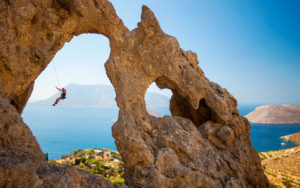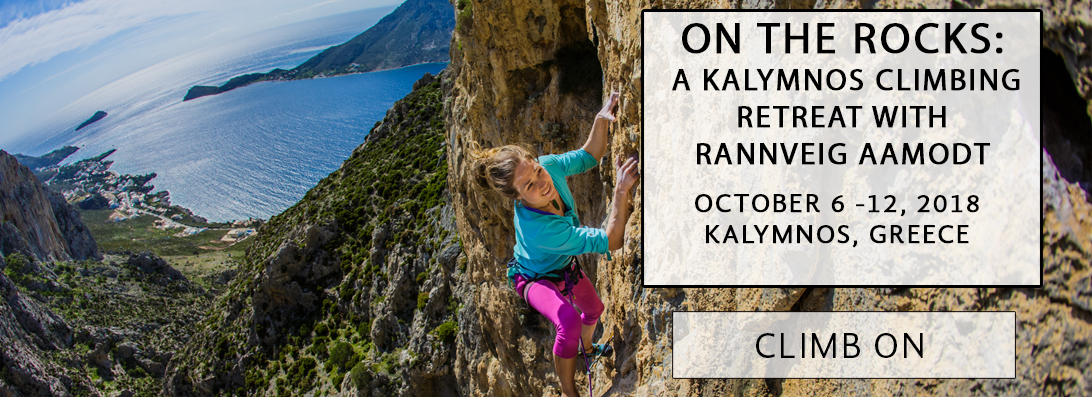
1. You’ve been to Kalymnos before; what are your favorite things about climbing on and traveling to this stunning Greek island?
Coming to Kalymnos as a rock climber is like discovering Nirvana. It’s a little island off the coast of mainland Greece and it might have the highest concentration of sport climbing routes anywhere in the world. The style of the rock climbing is varied but often very steep and three-dimensional. Many times I’ve found myself in an ocean of stalactites sticking out from the rock walls wondering which way to face my body. The broad variety of the difficulty of the climbing makes this place fun for climbers at all levels. You can often see people who are climbing for the first time in their life and elite level climbers at the same crag.
During the high season you’ve got climbers migrating here from every corner of the world and you can be guarantied to meet new people and reconnect with old friends. The climbing community is a quite interesting group of people. We are almost like different species of migrating birds who, year round, are chasing the weather for the best climbing condition. We all have different preferences of what temperatures we like to climb in. Some people prefer to spend their holiday in the sun and don’t mind the hot temperatures, and others, myself included, seek out the dry, cold and crisp conditions to optimize our performance. This makes it very likely to run into the same people in different countries year after year, and to bond with people from across the world. We all come from different backgrounds with different stories, but with a common intention in mind: to play on rock.
Not to mention the food. The Kalymnians like their Greek food. They put pride in their meals made from local ingredients. Everything is so fresh, and you can hand pick grapes, oranges, olives, lemons, figs and clementines. It’s not that hard to eat a meal that is completely local.
2. How did you find your way to climbing? When did you know it was more than just a hobby?
A famous Norwegian philosopher and mountaineer named Arne Næss summed it up by saying that when he was a kid, he didn’t start climbing – everyone else just stopped.
My older brother, a great climber, bought me climbing shoes for my 16th birthday, and brought me along, and my stubbornness kept me going until I got hooked. I was not one of those wonder kids who are born rock stars; I actually sucked when I started. But I loved being outside in the mountains and I loved the challenges and the adventures. For some reason I get really inspired when things feels hard for me. And climbing never seem to get easy, so I keep on trying hard!
Some years later, my idol at the time said while we were at the bouldering gym, “If you had only started earlier you could have become a professional climber.” Those words planted a seed in me, and in my stubborn mind I ignored the first part of what he said and left the gym with a smile. After seven years and hundreds of hours climbing on rocks around the world, I got my first sponsors. 
3. What is one thing people don’t realize about being a rock climber?
New climbers are often scared of the equipment, and they are hesitant to trust their lives to it. The thing is, few beginners realize how over engineered the gear is. The bolts and carabiners are so strong that you can hang a car off them! “What about the skinny rope?” they ask. Those skinny ropes can hold a few thousand pounds, and even more amazing, they stretch a lot in order to absorb the force of a fall – so in a way they are like big bungee cords. 
4. Who has been your greatest influence and why?
I don’t have a big legend that I look up to. It’s more a constant stream of climbing partners over the years that have influenced and inspired me. In the beginning, my brother and his group of friends were a huge inspiration to me. They were fascinating people who shared the same values as me: they’re passionate about nature, they’re creative, active, happy, and incredibly psyched. Amazingly, these traits are pretty common in many of the climbers I meet along the way.
Later on as I got more into climbing, I got more and more interested in exploring my potential and I met a lot of people who influenced me and inspired me to push myself closer to that limit. Stian Christophersen is a good example – he is my trainer and coach in Norway and has been instrumental in helping me get closer and closer to my limit. I knew a lot about training before I worked with him, but I realized that he saw me as an individual. He showed me how to customize my training to target my own weaknesses, when to climb through some injuries, and when to rest through others.
5. In 2012 you broke your back, both your ankles, your pelvis, and your elbow. Did you ever doubt whether you would get back on the rock? What did you have to overcome (mentally and physically) to get back in climbing shape?
In the days after the accident, I doubted a lot – I doubted that I was even going to be able to walk again. Once it became clear that I was going to be able to walk, I still wondered if climbing would be so scary or unenjoyable that I wouldn’t be able to find the same flow feeling I had always enjoyed about the sport. I decided early on that if it wasn’t enjoyable, I wasn’t going to force it or push it, and I’d find something else to do.
To get back into climbing shape, I had to overcome a lot of obstacles both physically and mentally. I was in a wheelchair for about three months and had almost no leg muscles at all. I had awful balance, terrible flexibility in my back, and I was weak and tired all the time. I still have skin damage on my big toe and climbing shoes can be super painful even years later.
I was in constant pain and had to understand what sorts of aches to listen to and what sorts of aches to ignore. In the first year after the accident, it was crazy painful to just rest my feet on the floor while I was sitting in bed. Walking to the crag hurt and I needed to use walking sticks.
One of the hardest things to overcome was the fear of never getting back to where I was, not just as a climber, but as a lover of wild places. I thrive on being out there in the woods, alone. Would I ever be able to hike deep into the backcountry again?
Perhaps the single hardest thing was to learn the importance of not using the accident as an excuse. My feet hurt, my back hurt, my elbow hurt, I was weak, and I was petrified of falling – I’m still struggling with that fear – but early on I made a conscious choice to start from scratch with a different body and mind. I didn’t want to blame any shortcomings on the accident. I just wanted to deal with them and overcome them.
 6. What are some of your passions other than rock climbing? Will these be explored during your retreat at all?
6. What are some of your passions other than rock climbing? Will these be explored during your retreat at all?
There are so many things I love: trail running, animals, coffee, food, music, yoga, and scuba diving. Kalymnos is one of the most beautiful places on the planet and it’s a great place for trail running, ocean sports and yoga. The focus of the trip will be climbing but there is certainly room for participants to explore other activities.
Learn more and sign up for Rannveig’s Kalymnos Climbing Retreat by clicking on the photo below:



